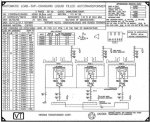mivey
Senior Member
The LTC is integrated with the main transformer. The regulator is a separate stand-alone unit.what is the difference between the LTC and voltage regulator, besides the percentage difference mentioned?
The LTC is like using a bus regulator where the whole station has the same output voltage. Okay when loads are balanced but I don't like it. I prefer single-phase feeder regulation where each feeder is adjusted based on load as is each phase.





